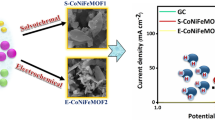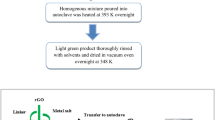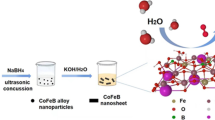Abstract
The oxygen evolution reaction (OER) is a crucial step in the development of electrochemical energy storage systems and conversion technologies, such as alkaline fuel cells, water-splitting, and rechargeable batteries. As a result, the design of efficient, low-cost and long-lasting OER electrocatalysts is one of the biggest modern day challenges in the field of renewable energies. Because of the high surface area, high porosity, and variable constitution, metal–organic frameworks are used as OER electrocatalysts. In this study, CoMo-H3BTC, Co-H3BTC and Mo-H3BTC were prepared using solvothermal method, at 135 °C for 16 h. The functional behavior, structure, morphology, and oxidation state of the electrocatalysts were analyzed by X-ray diffraction studies, Fourier transform infrared spectra, Scanning electron microscopy, Energy-dispersive X-ray, and X-ray photoelectron spectroscopy. The prepared CoMo-H3BTC composites showed high electrocatalytic properties toward OER as well as improved nitrosensing capabilities. CoMo-H3BTC demonstrates OER catalytic activity with overpotential of 320 mV at a current density of 10 mA cm−2 and a 59 mV dec−1 of Tafel slope value with good stability. Also, CoMo-H3BTC electrocatalysts have better sensing applications toward nitroaromatics such as nitrobenzene and 2, 4-dinitrotoluene with a detection limit of 0.128 µM and 0.197 µM, respectively. The excellent OER activity, low Tafel slope value, improved durability, and good nitrosensing ability of CoMo-H3BTC will meet the real-world applications.
Graphical abstract











Similar content being viewed by others
References
Vikrant K, Kumar V, Kim KH, Kukkar D (2017) Metal–organic frameworks (MOFs): potential and challenges for capture and abatement of ammonia. J Mater Chem A 5:22877–22896
Zhang W, Huang R, Song L, Shi X (2021) Cobalt-based metal–organic frameworks for the photocatalytic reduction of carbon dioxide. Nanoscale 13:9075–9090
Bavykina A, Kolobov N, Khan IS, Bau JA, Ramirez A, Gascon J (2020) Metal–organic frameworks in heterogeneous catalysis: recent progress, new trends, and future perspectives. Chem Rev 30:8468–8535
Yang D, Gates BC (2019) Catalysis by metal organic frameworks: perspective and suggestions for future research. ACS Catal 9:1779–1798
Alhumaimess MS (2020) Metal–organic frameworks and their catalytic applications. J Saudi Chem Soc 1:461–473
Zhao Y, Song Z, Li X, Sun Q, Cheng N, Lawes S, Sun X (2016) Metal organic frameworks for energy storage and conversion. Energy Stor Mater 2:35–62
Park J, Chae YS, Kang DW, Kang M, Choe JH, Kim S, Kim JY, Jeong YW, Hong CS (2021) Shaping of a metal-organic framework–polymer composite and its CO2 adsorption performances from humid indoor air. ACS Appl Mater Interfaces 18:25421–25427
Chavez A, Pattyn C, Vreeland E, Westlake K, Moorman M, Sammon J, Appelhans LN, Wright JB (2021) Metal organic framework functionalized sensors for detection of chemical agents. Image Sens Technol Mater Devices Syst Appl 8:11723–117230
Zhang S, Rong F, Guo C, Duan F, He L, Wang M, Zhang Z, Kang M, Du M (2021) Metal–organic frameworks (MOFs) based electrochemical biosensors for early cancer diagnosis in vitro. Coord Chem Rev 439:213948
Samanta P, Let S, Mandal W, Dutta S, Ghosh SK (2020) Luminescent metal–organic frameworks (LMOFs) as potential probes for the recognition of cationic water pollutants. Inorg Chem Front 7:1801–1821
Wang L, Zheng M, Xie Z (2018) Nanoscale metal–organic frameworks for drug delivery: a conventional platform with new promise. J Mater Chem B 6:707–717
Yaqoob L, Noor T, Iqbal N, Nasir H, Sohail M, Zaman N, Usman M (2020) Nanocomposites of cobalt benzene tricarboxylic acid MOF with rGO: an efficient and robust electrocatalyst for oxygen evolution reaction (OER). Renew Energy 156:1040–1054
Rameshkumar P, Viswanathan P, Ramaraj R (2014) Silicate sol–gel stabilized silver nanoparticles for sensor applications toward mercuric ions, hydrogen peroxide and nitrobenzene. Sens Actuators B Chem 202:1070–1077
Viswanathan P, Bhuvaneswari TS, Ramaraj R (2017) Investigation on the catalytic activity of aminosilane stabilized gold nanocatalysts towards the reduction of nitroaromatics. Colloids Surf A Physicochem Eng Asp 5:48–56
Zhao S, Zeng L, Cheng G, Yu L, Zeng H (2019) Ni/Co-based metal-organic frameworks as electrode material for high performance supercapacitors. Chin Chem Lett 30:605–609
Punde NS, Rawool CR, Rajpurohit AS, Karna SP, Srivastava AK (2018) Hybrid composite based on porous cobalt-benzenetricarboxylic acid metal organic framework and graphene nanosheets as high performance supercapacitor electrode. ChemistrySelect 3:11368–11380
Chithambararaj A, Mathi DB, Yogamalar NR, Bose AC (2015) Structural evolution and phase transition of [NH4] 6Mo7O24. 4H2O to 2D layered MoO3 − x. Mater Res Express 2:055004
Reddy R, Kailasa S, Rani BG, Jayarambabu N, Yasuhiko H, Ramana GV, Rao KV (2019) Hydrothermal approached 1-D molybdenum oxide nanostructures for high-performance supercapacitor application. SN Appl Sci 1:1–9
Xu J, Yang Y, Wang Y, Cao J, Chen Z (2019) Enhanced electrochemical properties of manganese-based metal organic framework materials for supercapacitors. J Appl Electrochem 49(11):1091–1102
Venkatachalam V, Alsalme A, Alghamdi A, Jayavel R (2017) Hexagonal-like NiCo2O4 nanostructure based high-performance supercapacitor electrodes. Ionics 23:977–984
Xia Y, Wei S, Huang Q, Li J, Cen X, Zhang H, Chu H, Sun L, Xu F, Huang P (2020) Facile synthesis of NiCo2O4-anchored reduced graphene oxide nanocomposites as efficient additives for improving the dehydrogenation behavior of lithium alanate. Inorg Chem Front 7:1257–1272
Zhu T, Zhang G, Hu T, He Z, Lu Y, Wang G, Guo H, Luo J, Lin C (2016) Chen Y Synthesis of NiCo2S4-based nanostructured electrodes supported on nickel foams with superior electrochemical performance. J Mater Sci 5:1903–1913
Salama RS, El-Hakam SA, Samra SE, El-Dafrawy SM, Ahmed AI (2018) Adsorption, equilibrium and kinetic studies on the removal of methyl orange dye from aqueous solution by using of copper metal organic framework (Cu-BDC). Int J Mod Chem 10:195–207
Yi T, Guo C, Zhao S, Zhan K, Gao W, Yang L, Du G (2020) The simultaneous preparation of nano cupric oxide (CuO) and phenol formaldehyde (PF) resin in one system: aimed to apply as wood adhesives. Eur J Wood Wood Prod 78:471–482
Padmanaban DB, Mohan L, Giri P, Bera P, Anandan C (2020) Barshilia, effect of molybdenum content on mechanical and tribological properties of diamond-like carbon coatings over titanium β-21S alloy. C 7:1
Thangasamy P, Shanmuganathan S, Subramanian V (2020) A NiCo-MOF nanosheet array based electrocatalyst for the oxygen evolution reaction. Nanoscale Adv 2:2073–2079
Wei G, He J, Zhang W, Zhao X, Qiu S, An C (2018) Rational design of Co (II) dominant and oxygen vacancy defective CuCo2O4@ CQDs hollow spheres for enhanced overall water splitting and supercapacitor performance. Inorg Chem 57:7380–7389
Sekar P, Murugesh N, Shanmugam R, Senthil Kumar S, Agnoli S, Chandran N, Vedachalam S (2021) Karvembu, phosphazene-based covalent organic polymer decorated with NiCo2O4 nanocuboids as a TrifunctionalElectrocatalyst: a unique replacement for the conventional electrocatalysts. ACS Appl Energy Mater 4:9341–9352
Gao S, Lin Y, Jiao X, Sun Y, Luo Q, Zhang W, Li D, Yang J, Xie J (2016) Partially oxidized atomic cobalt layers for carbon dioxide electroreduction to liquid fuel. Nature 529:68–71
Moysiadou A, Lee S, Hsu CS, Chen HM, Hu X (2020) Mechanism of oxygen evolution catalyzed by cobalt oxyhydroxide: cobalt superoxide species as a key intermediate and dioxygen release as a rate-determining step. J Am Chem Soc 142:11901–11914
Zhang X, Zhao R, Wu W, Li W, Shen C, Ni L, Yan H, Diao G, Chen M (2018) Ultrathin WS2 nanosheets vertically embedded in a hollow mesoporous carbon framework–a triple-shell structure with enhanced lithium storage and electrocatalytic properties. J Mater Chem A 6:19004–19012
Jiang J, Huang L, Liu X, Ai L (2017) Bioinspired cobalt–citrate metal–organic framework as an efficient electrocatalyst for water oxidation. ACS Appl Mater Interfaces 9:7193–7201
Liu M, Li J (2016) Cobalt phosphide hollow polyhedron as efficient bifunctional electrocatalysts for the evolution reaction of hydrogen and oxygen. ACS Appl Mater Interfaces 8:2158–2165
Feng X, Bo X, Guo L (2020) An advanced hollow bimetallic carbide/nitrogen-doped carbon nanotube for efficient catalysis of oxygen reduction and hydrogen evolution and oxygen evolution reaction. J Colloid Interface Sci 575:69–77
Maity K, Bhunia K, Pradhan D, Biradha K (2017) Co (II)-doped Cd-MOF as an efficient water oxidation catalyst: doubly interpenetrated boron nitride network with the encapsulation of free ligand containing pyridine moieties. ACS Appl Mater Interfaces 9:37548–37553
Meng Q, Yang J, Ma S, Zhai M, Lu J (2017) A porous cobalt (II) metal–organic framework with highly efficient electrocatalytic activity for the oxygen evolution reaction. Polymers 9:676
Yi X, He X, Yin F, Chen B, Li G, Yin H (2019) Co-CoO-Co3O4/N-doped carbon derived from metal-organic framework: the addition of carbon black for boosting oxygen electrocatalysis and Zn-Air battery. Electrochim Acta 295:966–977
Du J, Wang R, Lv YR, WeiL YL, Zang SQ (2019) One-step MOF-derived Co/Co 9 S 8 nanoparticles embedded in nitrogen, sulfur and oxygen ternary-doped porous carbon: an efficient electrocatalyst for overall water splitting. ChemComm 55:3203–3206
Gong Y, Xu Z, Pan H (2019) Facile synthesis and characterization of MOF-derived porous Co3O4 composite for oxygen evolution reaction. ChemistrySelect 31:1131–1137
Rameshkumar P, Ramaraj R (2014) Electroanalysis of nitrobenzene derivatives and nitrite ions using silver nanoparticles deposited silica spheres modified electrode. J Electroanal Chem 731:72–77
Acknowledgements
The authors would like to thank the Ministry of Human Resource Development and its Cumulative Professional Development Allowance (CPDA) for funding their research.
Author information
Authors and Affiliations
Contributions
BTS contributed to Conceptualization, Methodology, and Writing of the original draft. ST contributed to Formal analysis and Data curation. VMNB contributed to Supervision, Investigation, Resources, Visualization, and Validation.
Corresponding author
Ethics declarations
Competing interests
The authors declare no competing interests.
Additional information
Publisher’s Note
Springer Nature remains neutral with regard to jurisdictional claims in published maps and institutional affiliations.
Rights and permissions
Springer Nature or its licensor (e.g. a society or other partner) holds exclusive rights to this article under a publishing agreement with the author(s) or other rightsholder(s); author self-archiving of the accepted manuscript version of this article is solely governed by the terms of such publishing agreement and applicable law.
About this article
Cite this article
Subramanian, B.T., Thomas, S. & Biju, V.M.N. Trifunctional cobalt–molybdenum metal–organic framework for electrochemical oxygen evolution reaction and aromatic nitrosensing applications. J Appl Electrochem 54, 559–572 (2024). https://doi.org/10.1007/s10800-023-01977-x
Received:
Accepted:
Published:
Issue Date:
DOI: https://doi.org/10.1007/s10800-023-01977-x




